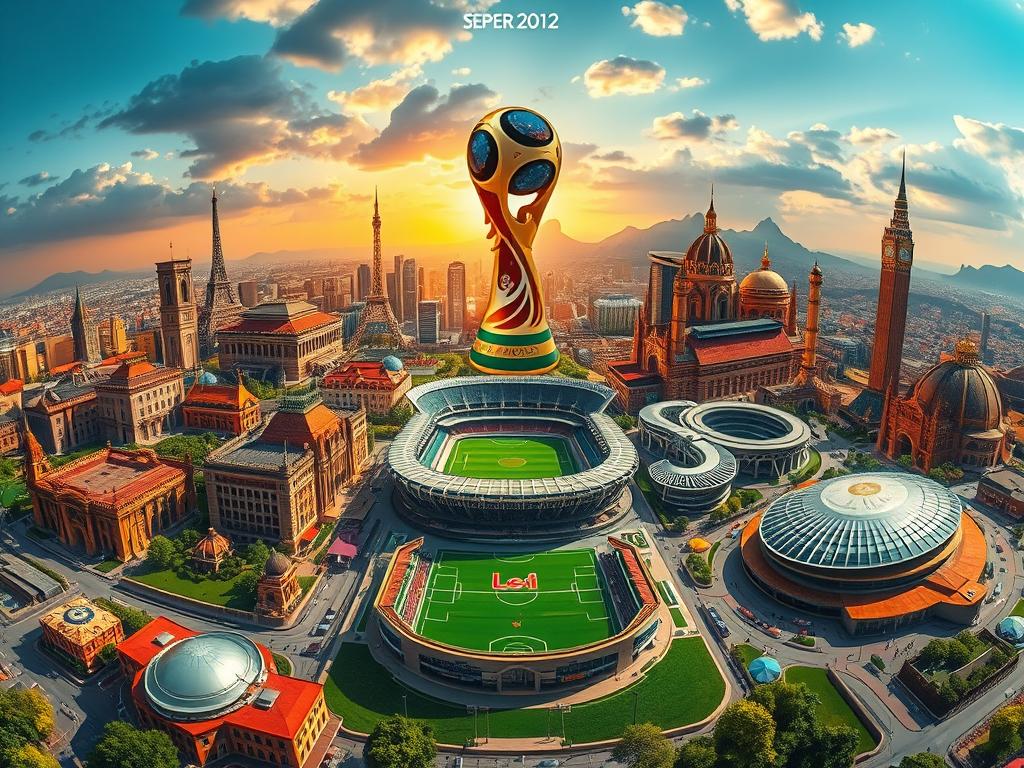Ever wondered where the next FIFA World Cup will take place? Soccer’s biggest tournament has evolved since 1930, with nations competing not just on the field but also to welcome fans worldwide. The excitement never fades as new locations emerge, each bringing unique energy to the game.
In 2026, Mexico makes history by hosting for the third time, joining the U.S. and Canada in a groundbreaking three-nation event. Fast forward to 2034, and Saudi Arabia steps into the spotlight as the first solo Middle Eastern host. The journey continues, blending tradition with fresh experiences.
Continental rotation and multi-nation bids now shape the future of this global celebration. From historic stadiums to fresh rivalries, the beautiful game keeps uniting us all.
Introduction to the FIFA World Cup Host Selection
From early chaos to modern reforms, FIFA World host selection has evolved significantly. In the 1930s, teams sailed for weeks to reach Uruguay, the first-ever host. Travel hurdles sparked debates, proving even then that logistics mattered as much as passion.
World War II forced cancellations in 1942 and 1946, pushing FIFA to formalize rotation policies. By the 2000s, the process became more structured. Today, nations must bid seven years in advance, with exceptions like the 2018/2022 joint announcement.
Modern host requirements are strict:
- Stadium capacity: Must seat 40,000+ for group matches.
- Infrastructure: Airports, hotels, and transit systems must handle millions.
- Security: Comprehensive safety plans are non-negotiable.
The 2026 edition breaks new ground with 48 teams, requiring three nations to share duties. FIFA also replaced continental rotation with “confederation cool-off” periods, ensuring fairness. The goal? A seamless tournament where football—not politics—takes center stage.
Confirmed Locations for Soccer’s Biggest Stage (2026–2034)
The next decade will rewrite the rules of global soccer hosting. From record-breaking formats to historic firsts, here’s where the action unfolds.

2026: A Tri-Nation Triumph
Picture this: 48 teams battling across 16 cities in the United States, Canada, and Mexico. The 2026 FIFA World breaks barriers as the first three-nation event. Mexico’s Estadio Azteca steals the spotlight—it’s the only venue to stage matches in 1970, 1986, and now 2026.
Key highlights:
- Expanded format: 16 host cities required to accommodate 80 matches.
- Fan experience: From New York to Guadalajara, cultures collide on and off the pitch.
2030: A Centennial Celebration
The 2030 World Cup honors 100 years of soccer history with a six-nation fiesta. Spain, Portugal, and Morocco kick off group stages, while Uruguay, Argentina, and Paraguay host the symbolic opener—a nod to the inaugural 1930 tournament.
Why it’s unique:
- Morocco’s milestone: First African nation to co-host.
- Globe-trotting finals: Matches span three continents in a single edition.
2034: Saudi Arabia’s Solo Debut
Saudi Arabia steps into the spotlight with a $100 billion infrastructure overhaul. Compact and high-tech, the 2034 event focuses on sustainability and fan immersion. Think futuristic stadiums and seamless transit—all under the desert sky.
Did you know? This marks the Middle East’s second tournament after Qatar 2022, but the first solo-hosted one.
How Host Countries of the World Cup Are Chosen
Behind every FIFA World Cup host announcement lies a rigorous, multi-step selection drama. Nations compete fiercely, but winning requires more than passion—it demands flawless planning and deep pockets.
The process kicks off seven years before the event. Bidding countries submit detailed proposals, showcasing stadiums, transit, and security plans. FIFA’s technical team then grades each bid on infrastructure (70%) and commercial potential (30%).
Since 2015, reforms have made voting transparent. Executives now disclose their picks publicly, a response to past corruption scandals. For the 2026 edition, the U.S.-led bid won 134–65 against Morocco after months of evaluation.
Key requirements for bidding nations:
- Venues: 12+ stadiums seating 40,000+ fans.
- Funding: $500 million+ in guarantees to cover costs.
- Legacy: Plans for post-tournament use of facilities.
The final vote is a showdown. Delegates from 211 member associations cast ballots, often swayed by geopolitics as much as merit. But one thing’s certain—the chosen nation earns a spot in soccer history.
Historical Highlights of World Cup Hosts
The journey of global soccer began with a small but groundbreaking event in 1930. Since then, tournaments have transformed from local gatherings to worldwide phenomena. Let’s revisit the milestones that shaped the game.

First World Cup: Uruguay 1930
Only 13 teams competed in the first world cup, with just four from Europe due to costly travel. Uruguay’s victory on home soil ignited a passion that still burns today. The event proved soccer could unite continents—despite the hurdles.
Fast-forward to 2026, and Europe will send 16 teams. The growth is staggering. Back then, matches drew 93,000 fans; now, billions tune in globally.
Multi-Host Tournaments: Japan & South Korea (2002)
The Japan South Korea collaboration broke new ground. Building 20 stadiums cost $4.5 billion, but the payoff was huge. Local leagues saw attendance spikes, and fans experienced two cultures in one tournament.
Key takeaways:
- K-League & J-League: Attendance surged by 40% post-event.
- Innovation: High-tech venues set new standards for fan comfort.
Other unforgettable moments:
- South Africa 2010: Boosted tourism by 500,000 visitors annually.
- Wartime gaps: Cancellations in 1942 and 1946 reminded us how precious peace is.
From Uruguay’s pioneer spirit to today’s mega-events, each host leaves a unique mark. The beautiful game keeps evolving, and so do its stages.
Regional Breakdown of World Cup Hosts
Soccer’s grandest stage has seen a fascinating geographic spread over the decades. Some regions dominate, while others are just beginning their hosting journeys. Let’s explore how FIFA zones shape the tournament’s legacy.
Europe’s Reign: UEFA claims 55% of all editions, with powerhouses like Germany, Italy, and France hosting multiple times. Their advanced infrastructure and deep soccer culture make them favorites.
South America’s Roots: The first tournament kicked off in Uruguay, and CONMEBOL nations like Brazil and Argentina kept the flame alive. Their passion is unmatched, but logistics often lag behind European standards.
Key milestones in other regions:
- AFC’s Rise: Japan and Korea’s 2002 co-hosting paved the way for Qatar (2022) and Saudi Arabia (2034).
- CAF’s Breakthrough: South Africa’s 2010 debut brought the tournament to Africa at last.
- OFC’s Future: Australia’s move to the AFC hints at potential bids down under.
North America makes history in 2026 with a three-nation collaboration. It’s a bold step toward balancing the global scale. One thing’s clear—the beautiful game thrives everywhere.
Unique Facts About World Cup Host Countries
Soccer history is full of surprises, especially when it comes to tournament locations. Some nations break records, while others rewrite the rulebook entirely. Let’s dive into the most remarkable hosting feats.
Mexico’s Record: First to Host Three Times
Picture this: a stadium so iconic it’s welcomed the men world cup three times. Estadio Azteca will make history again in 2026, having previously hosted in 1970 and 1986. No other venue has achieved this triple milestone.
Mexico City’s 7,350-foot altitude adds another layer of challenge. Thin air affects player stamina, creating unforgettable matches. The 1970 final here saw Brazil’s legendary 4-1 victory—still talked about today.
Key Azteca highlights:
- 1970: Pelé’s iconic header in the final
- 1986: Maradona’s “Hand of God” goal
- 2026: First venue to span 56 years of tournaments
Winter World Cup: Qatar 2022
The qatar 2022 edition shattered norms by moving to November-December. Why? Summer temperatures hit 115°F—too dangerous for players and fans. The shift created the first winter tournament in the event’s history.
Qatar spent $220 billion on infrastructure, including seven stadiums with revolutionary cooling tech. Air-conditioned pitches kept temperatures at 79°F, even during desert heat.
qatar 2022 by the numbers:
- 8 stadiums within 35 miles—closest ever
- 1.4 million visitors during the event
- 100% solar-powered venues
Meanwhile, the U.S. still holds the attendance record from 1994—3.6 million tickets sold. Italy remains the only nation to win on home soil twice (1934, 1982). Every host leaves its mark in unexpected ways.
The Economic and Cultural Impact of Hosting
Stadiums fill with cheers, but the real game-changer happens off the pitch. Hosting soccer’s premier event delivers an economic boost and cultural shifts that echo for four years—or longer.
Russia’s 2018 tournament cost $14 billion but drew $3 billion in tourism revenue. Brazil welcomed 3.7 million visitors in 2014, while Germany created 50,000 jobs in 2006. The math is clear: short-term gains are massive.
But legacy costs linger. Stadium maintenance often drains budgets post-event. Qatar’s 2022 solution? Modular venues dismantled into community spaces. Smart planning turns white elephants into assets.
Cultural diplomacy shines too. Qatar used the sports spotlight to modernize its global image. Meanwhile, the U.S. saw youth soccer participation double after 1994—proof that inspiring the next generation matters.
Looking ahead, 2026 aims higher:
- 5 million tickets (vs. 1994’s 3.6M record)
- $7 billion in sponsor activations
- Grassroots programs to fuel fan growth
From cash flow to cultural clout, hosting reshapes the world’s view of a nation. The final whistle is just the beginning.
What’s Next for the World Cup?
From desert stadiums to AI referees, the sport is leveling up. The 2034 Saudi Arabia edition will showcase cutting-edge tech, but the real game-changer? Expanding to 64 teams by 2038.
Climate challenges are reshaping venue choices. Future bids may prioritize cooler months or indoor arenas. Africa could step up next—Nigeria and Ghana are rumored to team up.
Tech will dazzle fans too. Think 8K broadcasts and AI-assisted VAR. Yet the heart of it all remains the same: every four years, the men world unites under one passion.
No matter the format or location, soccer’s magic endures. The next chapter promises more goals, more drama, and more unforgettable moments.







